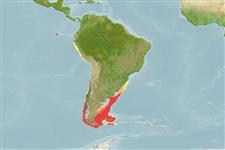Common names from other countries
Environment: milieu / climate zone / depth range / distribution range
Ekologi
; kisaran kedalaman 0 - 228 m (Ref. 87801). Temperate
Southern Ocean.
Length at first maturity / Size / Weight / umur
Maturity: Lm ? range ? - ? cm
It burrows in mud and sand in the intertidal to a depth of 228 m (Ref. 87801).
Life cycle and mating behavior
Kematangan | Reproduksi, perkembang biakan | Pemijahan | telur-telur | Fecundity | Larva
Members of the class Holothuroidea are gonochoric and have only one gonad. Spawning and fertilization are both external and some exhibit brooding. Life cycle: Embryos develop into planktotrophic larvae (auricularia) then into doliolaria (barrel-shaped stage) which later metamorphose into juvenile sea cucumbers.
rujukan utama
Acuan | Koordinator | mitra
Häussermann, V. and G. Försterra. 2009. (Ref. 87801)
Status IUCN Red List (Ref. 130435)
status CITES (Ref. 108899)
Not Evaluated
Not Evaluated
ancaman kepada manusia
Harmless
penggunaan manusia
| FishSource |
Alat, peralatan
informasi lanjut
Umur / SaizPertumbuhanpanjang-beratpanjang-panjangMorfologiLarvaKelimpahan
Sumber internet
Estimates based on models
Preferred temperature
(Ref.
115969): 5.5 - 14.6, mean 7.6 (based on 313 cells).
